Monday 24 June 2013
White-fronted capuchin - able to find what is under the rock.
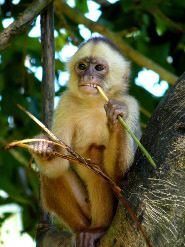
The
White-fronted Capuchin (
Cebus albifrons) is a small, omnivorous monkey found throughout the northern half of South America. The primate's range currently stretches across seven countries: Bolivia, Brazil, Colombia, Venezuela, Ecuador, Peru, and Trinidad. The animal was discovered by Alexander von Humboldt in 1812, although there was some confusion about the description of the animal because of the various colors found across the 5 different subspecies. The
primate is usually a creamy white color in front (hence the name White-fronted Capuchin), although the area that is "white" in the front can range from a creamy white color to a cinnamon brown color depending on the subspecies. Males are larger than females, with males averaging 3.4 kg (7.5 lb) while females average 2.9 kg (6.4 lb).
While the primate is primarily arboreal, it forages for food at all different levels of the forest. The animal often goes to the forest floor to obtain its diet that consists primarily of fruits, insects, frogs, lizards, and bird eggs. One of the notable traits of the White-fronted Capuchin is that it is a primate that is capable of manipulating objects; while it is common for larger, more advanced primates like chimpanzee to manipulate objects, the White-fronted Capuchin is one of the few small primates that have exhibited this trait. The White-fronted Capuchin has been observed in the wild examining leaves and turning them over to find insects and other food sources, and this ability is an example of adaptibility and intelligence that is not common in the smaller primates. The primate forms social groups called troops, with the older, alpha males leading the group and protecting members of the group from other troops and predators. Males are polygamous, and the gestation period for the primate is 160 days.
Only one baby is born at a time, and all members of a troop participate in playing with and helping raise the young.
The major predators of the White-fronted Capuchin are the boa constrictor and a bird of prey that shares its habitat called the Double-toothed Kite. When confronted with a predator, the primate will either exhibit aggressive behavior or descend to the forest floor and run. Aggressive behavior to predators or intruders typically takes the form of screams and the breaking of branches. Because of its wide range and ability to adapt, the White-fronted Capuchin is not yet considered endangered. There is, however, a concern that as their habitats continue to shrink in South America, the White-fronted Capuchin population may decrease.
Picture of the white-fronted capuchin by Whaldener Endo, licensed under
Creative Commons Attribution 2.5 Generic
You can help spreading the word about this animal by liking it on facebook
Permanent Link
Thursday 20 June 2013
Giant Noctule - Preying on nocturnal birds
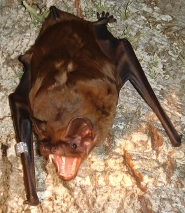
The
Giant Noctule (
Nyctalus lasiopterus) is a rare, flying mammal also known as the Greater Noctule Bat. They are found scattered around the Iberian Peninsula in southwest Europe, the Balkans in southeastern Europe, and the Ural region in western Russia. They have also been spotted in Morocco and Libya in northern Africa, as well as in Turkey, northern Iran, and Kazakhstan.
These bats weigh approximately 1.7 ounces (50 grams), and possess a wingspan of up to 23 inches (60 cm). Despite their small stature, they are surprisingly predatory, and small passerine
birds who migrate at night are in danger. Within the past decade, it has been found that Giant Noctules chase, catch, and eat fowl prey while in flight.
They use echolocation to navigate, forage, and hunt in the dark. They echolocate within specific frequency ranges that are above the hearing range of birds, which gives the bats the upper hand during the hunt. They fly higher up in the air, upwards of .3 miles (500 meters) to find prey, and researchers believe that spring and autumn, peak months for bird migration, are prime hunting seasons for these predatory bats.
During peak migration periods, the diet of Giant Noctules consists largely of passerine, or small perching birds. These birds are caught and eaten on the wing, in mid-air during flight, rather than from nests or perches. This species is the only known bat species that feeds like this, see also
this article. Insects are also an important source of food. They have a few natural predators in the wild including owls, which can capture bats during flight, just as Giant Noctules capture passerine birds.
They are native to certain countries in Europe, North Africa, and West Asia including Spain, France, Bulgaria, Romania, and the Ukraine. Their natural habitat consists of mixed and deciduous forests, as well as wooded river valleys. The Giant Noctules are highly dependent on mature woodlands containing old trees. They use hollow trees to roost in summertime, and rock crevices during the winter months, which are a time of hibernation. Old buildings are also common roosting sites.
Giant Noctules are considered to be a near threatened animal. Their population appears to be decreasing due largely to deforestation. In particular, the loss of old trees, which are crucial to supporting bat colonies, and the disturbance of other roosting sites, such as old buildings, threaten these small, remarkable creatures' survival.
Picture of the giant noctule by Nicol Harper, licensed under
Creative Commons Attribution 2.5 Generic license.
You can help spreading the word about this animal by liking it on facebook
Permanent Link
Tuesday 18 June 2013
Black Dolphins - one of the smallest species of all of the cetaceans
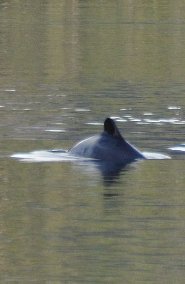 Black dolphins
Black dolphins (
Cephalorhynchus eutropia) are known by many other names such as Chilean dolphins, Chilean black dolphins, and white-bellied dolphins. These small cetaceans have blunt, beakless heads and a stock body shape. The average length of this dolphin is 67 inches (1.7 m) and a mature dolphin weighs around 132.27 lbs (60 kg). Their flippers and the large dorsal fin are round in shape. The color of the coat is gray but the ventral sides are light in color. There are white markings on their forehead, throat, lips, and in the area behind their flippers. There is a dark gray band round their throat. There are vertical lines known as fetal folds on a baby black dolphin. It is believed that before birth, the calf is tightly curved in its mother's womb.
Black dolphins are mainly found in cold water. Their habitats are in the shallow coastal waters of Chile, South America, Argentina, Cape Horn, Beagle Channel, and to the south of Isla Navarino. This species is thought to be highly gregarious since they roam about in small groups of 2 to 10 individuals. In the northern range, there are 20 to 50 individuals in a group. Valdivia near Chiloe and the gulf of Arauco are places where these dolphins are found in abundance.
Black dolphins like feeding on crustaceans, fish, and cephalopods. They also eat fish as anchovies, sardines, schooling fish, and squids. Their diet sometimes also includes green algae. There is no information about the reproduction pattern of Black dolphins yet.
Just like other species of dolphins, the black dolphins can also swim very fast. They can cover short distances rapidly with a speed of 20 mph. Then they sense any kind of danger, they swim even faster but at the same time, they get tired soon. At a normal speed, they can swim for hours and can cover long distances with a speed of 4 to 6 mph. Some population of the Black dolphins may migrate seasonally but others remain in one area through out the year.
In southern Chile, dolphins which accidentally get trapped in nets are used as bait to lure crabs or for human consumption. The complex channels and islands make it impossible to protect this species against hunting. The increasing aquaculture industry may have also invaded the habitats of black dolphins.
Picture of the black dolphin by Frank Holden, licensed under
Creative Commons Attribution ShareAlike 3.0
You can help spreading the word about this animal by liking it on facebook
Permanent Link
Monday 17 June 2013
Topi - Socialites of the Serengeti
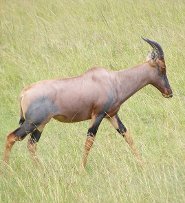 Topi
Topi (
Damaliscus lunatus) are a medium-sized species of antelope that make their home in the southern regions of Sudan and the Serengeti National Park in Tanzania. Because of hunting and a loss of their natural habitat, Topi populations are scattered and isolated among the area. They prefer the Serengeti because of the large spreads of flood plains there. While their preferable habitat is this flat lowland, they can also be found in dry, open savanna and woodlands. If they have access to fresh green grasses, Topi can go without water for long stretches of time, taking to the shade of the trees during the hot daytime hours.
Topi have coats that vary in color from a distinct reddish-brown to a purple-tinted red. They have black patches on their head, upper legs, thighs, and hips. Their legs are yellow-tan in color that, combined with the bands of black, make them look like they are wearing stockings. Although females are a bit lighter in color than males, they both have back-curving horns about 21 inches (53.34 cm) long. Topi stand at a height of 3.5 to 4.5 feet (106.68 to 137.16 cm) and weigh 200 to 300 pounds (90.7 to 136.1 kg). Their average lifespan is 15 years, with females reaching maturity at 1.5 years and males maturing at 3 years.
Topi eat grass and only grass. They have a thin muzzle that had adapted so they can pick and choose the most succulent blades. If fresh grasses are available, they can provide water for the topi as well as food. If the grasses are dry or unavailable, they must drink water daily.
Topi are considered one of the most social mammal species of the Serengeti. They live in herds of 15 to 20, but have been seen in groups numbering in the hundreds. The social structure is considered very flexible for herd animals, although they are led by a dominant male. When large herds take a break from movement, the males create for themselves separate mini-territories in which they keep their females. Males vie for their own territory at the age of 4 or 5 years, but very few are yet powerful enough to win them. Mating is done strictly within the territories of the dominant males and timed so that birth occurs during seasons where feeding grasses are plentiful. Usually, this means breeding is done once per year, but in particularly good years, they will adjust and breed two or more times.
Topi do not limit their sociability to their own species. They can often be found among herds of other antelope, wildebeests, zebras, or even ostriches. Because they love to be around other species, they often must compete with them for resources such as food and water. Limited resources are their biggest threat, because of their speed. However, they still serve as prey for fast cats such as leopards and cheetahs. As well, they can also be hunted by lions and hyenas.
You can help spreading the word about this animal by liking it on facebook
Permanent Link
Friday 14 June 2013
The Short, Happy Life of the Gray Slender Mouse Opossum
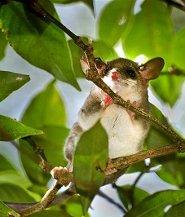
The
gray slender mouse opossum (
Marmosops incanus) is a little-known mammal that lives in the lower coastal region of Brazil. An interesting characteristic of the species is its very brief lifespan. Females typically live approximately a year and a half, undergoing only one reproductive cycle. Males live just a year, dying shortly after they mate.
Grayish-brown in primary color with a creamy underside, the wiry creature has a long, thin tail (38-63 centimeters/15-25 inches) that's longer than its body (25-43 centimeters/10-17 inches). It weighs no more than 170 grams/6 ounces; males are substantially longer and heavier than females. The animal is conspicuous for its disproportionately large ears, more than 2.5 centimeters/1 inch in length. The pelage (hair, or fur) is soft and long at first; it becomes short by the time the animal reaches adulthood. As with other opossum species, the rings around the eyes are prominent.
This species of opossum is rather versatile. It thrives in rainforest, deciduous forest and scrub forest environs. It's found most commonly in Brazil’s warm, humid coastal zone. It also can live in the higher, drier eastern mountain forests and even on the country’s inland plateau. The pelage of
opossums living in coastal areas is notably darker than that of their inland cousins.
Although its general range of habitat is confined to eastern Brazil, the animal is not endangered or at risk.
Breeding takes place primarily in the autumn. In at least one population, a second breeding period is known to occur in spring. Basically, the young opossums are born fatherless. The mothers, generally more active than males, survive the fathers by only a few months. This is especially interesting because newborn grey slender mouse opossums are markedly altricial. This means they are frail and very vulnerable to predators and conditions, as contrasted with more immediately independent (precocial) young animals of other species.
The gray slender mouse opossum is diversely equipped and is at home both on the ground (terrestrial) and in trees (arboreal). It is an insect feeder. Its main prey are the Coleoptera and Orthoptera insect orders.
The animal’s scientific name was
Marmosa incana until recent years; previously,
Marmosops was considered part of the
Marmosa genus.
Picture of the gray slender mouse opossum by Ramon Campos, licensed under
GNU Free Documentation License
You can help spreading the word about this animal by liking it on facebook
Permanent Link
Thursday 13 June 2013
Golden-crowned sifaka - only ten forest patches left
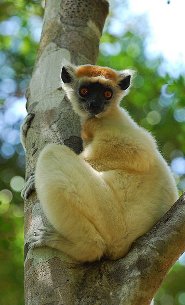
The
Golden-crowned Sifaka (
Propithecus tattersalli) is native to Madagascar, an island off the southeastern coast of Africa. Madagascar, is an island of unique biodiversity.The northern part of this island is home to the Golden-crowned Sifaka, a member of the primate family known as a lemur. It is about the size of a house cat and weighs in at around 3 kilograms. With a honey colored body, light under-belly, long tail, dark face with bright eyes, they are a sight to behold. The crown of the head is deeper in color than the body; it is golden.
The Golden-crowned Sifaka has a social structure that includes gathering together, foraging for food, and they are monogamous - they mate for life, and produce a single offspring at a time. Their diet is primarily foliage from the trees of the conifer forests. They also eat some flowers, seeds, and in the dry season, they are known to eat bark.
They travel the trees by swinging from limb to limb for food, using their long tails as a third hand to grasp with and have forelegs that are more like arms and hands than paws, and hind legs that are longer than the forelegs allowing for leaping when on the ground. They leap bipedally; on their hind legs. They are graceful, well balanced, gentle, and communicate vocally with a variety of calls.
Northern Madagascar is being harvested. It is having its forests destroyed for agricultural lands, harvesting of hardwoods, its land pillaged for gold, and its wildlife hunted (poached) for food. Slaughtered in large numbers, the lemur population is dropping quickly, placing them on the endangered list. As of 2008, only ten forest patches that could support viable populations remained, according to the IUCN.
Picture of the golden-crowned lemur by Jeff Gibbs, licensed under
Creative Commons Attribution-Share Alike 3.0 Unported license.
You can help spreading the word about this animal by liking it on facebook
Permanent Link
Wednesday 12 June 2013
Goeldi's Marmosets - A Rare Sight
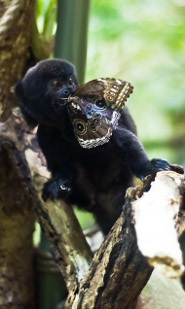
Marmosets are found in three categories, the tamarins, the true marmosets, and the Goeldi's Monkey or
Goeldi's marmoset (
Callimico goeldii). The
Amazon River Basin is its main habitat. It is black in color and has a mane. This species does not give birth to twins and is different from other marmosets, since it possesses three sets of molars. Previously, the Goeldi's monkey was believed to be an evolutionary species between New World Monkeys and the other marmosets, but molecular genetic recently indicated that it belongs to the marmoset species.
The lower canine teeth of real marmosets (the Callithrix genus) are short while the lower teeth of the other species called tamarins marmosets are comparatively longer. The smallest real marmoset, the
pygmy marmoset, lives in the upper parts of the rainforests in the Amazon River Basin region. Pygmy marmosets are just 14 cm long from head to body and its tail is relatively longer. The weight of the adult marmosets is about 3 ounce (90 grams), whereas the other species of this family attain 1.3 pounds (600 gm or 21.16 oz) or more.
The Goeldi's marmoset is blackish-brown or blackish in color and there is hair on its head and the tail sometimes has white, red, or brown colored highlights with silver lining. The length of the body is about 20 to 23cm (8 to 9 inches), and its tail is about 25 to 30 cm (10 to 12 inches) long. The Goeldi's monkey was discovered in 1904 by
Emil Goeldi.
At 8.5 months, the females become sexual mature while the males mature sexually at the age of 16.5 months. After 140 -180 days the young are born. The female is capable of giving birth twice a year. Unlike other species of this family, the mother bears only one baby at a time. The mother takes care of the baby till the initial 2-3 weeks and then, the father takes the responsibility of the baby except for satisfying its nursing requirements. The mother feeds the baby only up to the time it becomes 65 days old. The ratio of female to male is 2 to 1 and they can live up to 10 years in captivity.
Goeldi's monkeys like foraging in scrubby but dense bushes. This is probably the reason that this species is very rare. They live in separate patches at a suitable habitat, which are separated by kilometers of unsuitable flora. In wet seasons, it feeds itself with fruits, lizards, insects, spiders, snakes and frogs. In dry season, it survives on fungi and is the only tropical primate known to thrive on such a source of food. It lives in small groups of 6-7 individuals and stays within a distance of a few feet of each other.
Picture of the Goeldi's marmoset by Alexandre Buisse, licensed under
GFDL
You can help spreading the word about this animal by liking it on facebook
Permanent Link
Monday 10 June 2013
The Tree Pangolin - Africa's little ball of armor
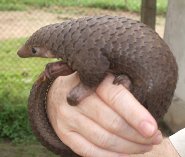
The
tree pangolin (Manis tricuspis) is a small mammal that lives in the rainforest of west to central Africa. It weighs approximately 4-5 lbs (about 2 kg) and is an anteater. The body of the tree pangolin is almost completely covered in hard scales which serve to protect it from predators. The scales each have three sharp points and are layered over the entire body except for the underbelly and parts of the head. The tree pangolin has a long thick tail that is also covered in scales and helps provide support as the tree pangolin climbs the trees of the rain forest.
The main predators of the tree pangolin are
leopards,
hyenas, and pythons. When approached by a predator, the tree pangolin rolls into a ball. The hard scales serve as a coat of armor and are sharp enough to injure a predator. The tree pangolin can also secrete a smelly substance from their anal glands which will also scare off a predator.
The female and male tree pangolins live alone unless the female is raising her young. The males will roam during mating season and each female will give birth to one offspring. The gestation period is 150 days and the newborn will stay with the mother for about 4 months. During that time, the mother will protect the newborn by rolling into a ball around it. The infant cannot walk for a few weeks after birth so it attaches to the mother's tail and is carried around through the trees.
The tree pangolins survive on a diet of ants, termites, and other insects. They use their claws to dig in the ground to search for food and then they capture insects with their long tongues that are coated in thick saliva. They have no teeth so they digest food by swallowing small rocks and sand that grind the food once it reaches the stomach.
The status of the tree pangolin is "near threatened" and they have been hunted by man for their meat and scales. Some cultures believe that the scales have healing powers and will protect them against evil.
Picture of the tree pangolin by Valerius Tygart, licensed under
Creative Commons Attribution-Share Alike 3.0 Unported
You can help spreading the word about this animal by liking it on facebook
Permanent Link
Thursday 06 June 2013
Blue Monkey - A Social Native of Africa
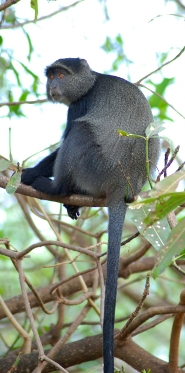
The
Blue Monkey (
Cercopithecus mitis) also known as the Diademed Monkey is a member of the guenon genus. It is native to East and Central Africa, Ranging from the northern part of the Congo River Basin to the east of the Great Rift Valley and to the south of northern Zambia and Angola.
Although, called 'Blue Monkey', the 'blue' is not really noticeable. The small hair on its face sometimes gives the impression of blue color and hence its name. Apart from its face, its coat is grey or olive in color and there is a yellowish patch on its forehead called the 'Diadem' from which the name Diademed Monkey has been derived. Its legs, feet, and cap are black and the mantle is brown, grey, or olive depending on the species. The Blue Monkey has pouch in its cheeks to carry food while foraging. An average mature blue monkey is 19.68 - 25.59 inches (50 - 65 cm) long and the length of its tail is equal to the length of the rest of its body. The female blue monkey weighs about 8.81 lbs (over 4 kg) and the weight of the male is about 17.63 lbs (8 kg).
The Blue Monkey is mainly found in bamboo forests, evergreen forests, and in thick forest canopies. It very rarely comes to the ground. In order to meet its need of water, it depends on the humid and shady areas where water is found in plenty. Leaves and fruits are its main food but it sometimes eats slow moving invertebrates as well. Tall trees are its most preferred home where it gets both the required shelter and food. Since the green cover is vanishing rapidly, it is also suffering the loss of its natural habitat like other animals. At places where the pine trees are replacing the natural green cover, the blue monkey is considered a threat as it may strip the bark in search of food and moisture. Humans also hunt it for its bushmeat.
The Blue Monkey males are larger than the females. Females generally give birth once in two years during the start of warm, moist rainy seasons. The gestation period lasts for about 5 months. Infants take birth with their eyes open and fur all over their body. The Blue Monkey roosts in groups of 10-40 individuals with only one adult male.
This species believes in the unmale-per-group tendency and the male receives the copulations from the females in the group. The male guards the group from any predators and females also join him in this activity. The stronger male sometimes ousts the male thereby overtaking the troop. In order to protect themselves from predators, these Blue Monkeys get mixed with other species of monkeys. No competition is seen between the two groups since they forage in diverse locations.
This species has a variety of habitats but it always stays close to water. Somalia, Angola, South Africa, Zambia, Zimbabwe, Uganda, Tanzania, Sudan, Malawi, Kenya Burundi, Ethiopia, Zaire, Rwanda, and Mozambique are countries where the Blue Monkey is found in abundance.
Picture of the blue monkey by Pedro Gonnet, licensed under
Creative Commons Attribution 2.5 License.
You can help spreading the word about this animal by liking it on facebook
Permanent Link
Wednesday 05 June 2013
The Lesser Bilby - Australia's Desert Omnivore
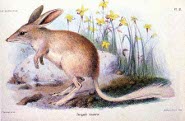
The
Lesser bilby (
macrotis leucura), also known as the yallara, the lesser rabbit-eared bandicoot, or the white-tailed rabbit-eared bandicoot, was a desert animal native to the center of the Australian continent. Similar in size to a juvenile rabbit, this animal was a marsupial, meaning females have no placenta and wean their young in an external pouch after birth. Unfortunately, this creature has been listed as extinct as early as 1950.
It was first discovered in 1887, observed to inhabit the Gibson and Great Sandy deserts of Australia. Its diet consisted of insects such as native ants and termites and plant roots. Full grown, it reached a weight of between 300 and 450 grams, or less than a pound (10.58 to 15.87 ounces). This tiny animal had a body of grayed brown that receded to a light gray and white on the tail. It made its home in dunes burrowed between two and three meters (about 6.6 to 9.8 feet) in, covering the opening with loose sand during the day and emerging during night. The burrows protected the animal not only from its main predators, birds and foxes, but also from the harsh sun. Females typically gave birth to two young, most likely on a seasonal basis.
It is unknown if this animal’s habitat extended beyond the central deserts. Trappers, predators, including the Aboriginal population, and territorial competition from rabbits forced the lesser bilby into extinction before it could be fully studied. The last living specimens, about a dozen in number, were collected in Cooncherie Station in 1932. The last specimen, a skull bone, was collected near an eagle’s nest in 1967. Dating revealed these bones to be less than 15 years of age, placing the extinction date around 1950.
The lesser bilby gained its fame for its omnivorous diet, eating both animals and plants, and its survival in a harsh desert climate. The
greater bilby, a close relative in the bandicoot family, still exists but is now endangered. Unlike the greater bilby, known to be a docile creature, the lesser bilby was a temperamental creature, resisting handling by researchers by hissing and biting. Sadly, despite its varied diet and its relatively safe habitat, the lesser bilby lost its place in the animal world.
You can help spreading the word about this animal by liking it on facebook
Permanent Link
Monday 03 June 2013
Tamarisk gerbil - Multi-colored Rodent
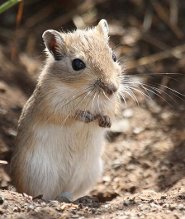
The Tamarisk gerbil (
Meriones unguiculatus) is also known as Mongolian or Tamarisk Jird and also called 'sand rat'. These small burrowing desert rodents have long hind legs used for leaping and running away from predators. They were named by Milne-Edwards.
Tamarisk gerbils normally have 15-18 centimeters (6-7 inches) head measurement, and their furry tails can extend up to 15 centimeters (6 inches) and are bushy towards the tip. These cute animals are preferred pets due to their gentle temperament. These social creatures vary in coat’s color from Yellow to Sandy or Gray or Dark Brown otherwise a classier Golden Agouti, Black, Argente, Lilac, Dove, Sapphire, Silver or Ivory Cream and others.
However, it was not until 1954 when they became popular pets but prior to that they roamed the deserts and steppes of different regions in the world. While these rodents are natural carriers of plagues and diseases, they are kept as pets and used as experimental animals. Like the Hamster, they are used for research or scientific testing.
These animals are abundant everywhere from the Mongolian desert, to the
Russian Federation,
Kazakhstan,
Kyrgyzstan,
Tajikistan,
Turkmenistan,
Uzbekistan and also in
China. However, while considered rare in some areas they are not definitely considered endangered. However, the possibility of extinction may depend greatly on habitat degradation, water loss or droughts and least likely on human disturbance.
These animals do not usually grow in colonies but normally live in family groups. The female gerbil usually gives birth up to 3 times per year. They thrive on
grassland, scrublands,
desert, plantation and terrestrial areas. They survive on cold and dry winters and also on hot summers. Those family groups of gerbils who live in deserts may grow in extinction due to trampling of camels and other large animals.
These intelligent mammals live in burrows with around 10-20 exits. These exits provide a way of escape for their common predators like snakes and birds of prey. Tamarisk gerbils in the wild feed on seeds and vegetation, domesticated gerbils on the other hand may be fed with food mix usually labeled as hamster and gerbil food.
You can help spreading the word about this animal by liking it on facebook
Permanent Link
 The White-fronted Capuchin (Cebus albifrons) is a small, omnivorous monkey found throughout the northern half of South America. The primate's range currently stretches across seven countries: Bolivia, Brazil, Colombia, Venezuela, Ecuador, Peru, and Trinidad. The animal was discovered by Alexander von Humboldt in 1812, although there was some confusion about the description of the animal because of the various colors found across the 5 different subspecies. The primate is usually a creamy white color in front (hence the name White-fronted Capuchin), although the area that is "white" in the front can range from a creamy white color to a cinnamon brown color depending on the subspecies. Males are larger than females, with males averaging 3.4 kg (7.5 lb) while females average 2.9 kg (6.4 lb).
The White-fronted Capuchin (Cebus albifrons) is a small, omnivorous monkey found throughout the northern half of South America. The primate's range currently stretches across seven countries: Bolivia, Brazil, Colombia, Venezuela, Ecuador, Peru, and Trinidad. The animal was discovered by Alexander von Humboldt in 1812, although there was some confusion about the description of the animal because of the various colors found across the 5 different subspecies. The primate is usually a creamy white color in front (hence the name White-fronted Capuchin), although the area that is "white" in the front can range from a creamy white color to a cinnamon brown color depending on the subspecies. Males are larger than females, with males averaging 3.4 kg (7.5 lb) while females average 2.9 kg (6.4 lb).
 The
The 

 The
The  The
The  Marmosets are found in three categories, the tamarins, the true marmosets, and the Goeldi's Monkey or
Marmosets are found in three categories, the tamarins, the true marmosets, and the Goeldi's Monkey or  The
The  The
The  The
The  The Tamarisk gerbil (Meriones unguiculatus) is also known as Mongolian or Tamarisk Jird and also called 'sand rat'. These small burrowing desert rodents have long hind legs used for leaping and running away from predators. They were named by Milne-Edwards.
The Tamarisk gerbil (Meriones unguiculatus) is also known as Mongolian or Tamarisk Jird and also called 'sand rat'. These small burrowing desert rodents have long hind legs used for leaping and running away from predators. They were named by Milne-Edwards.